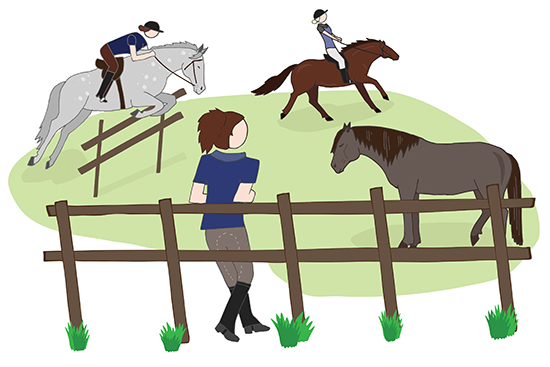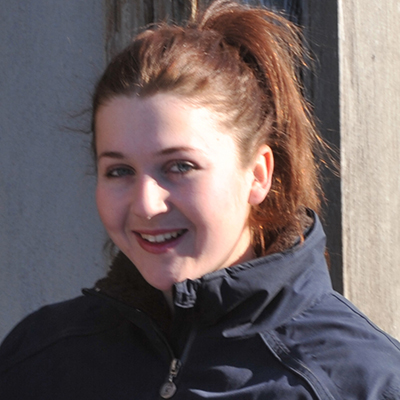 Young Australian showjumping rider Hayley Coman is back in her homeland. We asked to her to think about how to successfully buy the horse of your dreams…
Young Australian showjumping rider Hayley Coman is back in her homeland. We asked to her to think about how to successfully buy the horse of your dreams…
Everyone who has ever bought horses, has, almost definitely at some time, bought the wrong one. Whether it be the wrong type, the wrong breed, height, sex, age, colour or even level; we have all been there.
There are always problems associated with buying a horse, and I am going to discuss the Seven Points I have developed as the result of misinformation, incorrect or plain bad judgement.
First – What do you really want?
Before you race out and start looking at horses, I think it is essential that you sit down, think, and determine, the desirable traits and qualities that you seek in a horse. Now without being petty, this is where you can make a ‘wish-list’ of everything you would like the horse to possess. Think about what age and level, which go hand in hand: you may want a young horse to produce, to put your own stamp on, a going horse (middle aged) something that has done a bit, has a few miles but that you can essentially finish off. Maybe a school master, been there, done that, or a baby, a yearling, or two/three year old that is yet to be started. Essentially then you are buying something based on potential alone.
Second – What do you really need?
You then need to accurately and honestly assess your own personal needs. Be ‘REALISTIC’ when it comes to what it is you need. Need, being the key word. As in most phases of life, what we want, and what we need are often at opposite ends of the spectrum. For example, generally speaking a small or petite girl, is not in need of something 18 hands high. You will more than likely spend a substantial amount of time trying to transform a ferry into a sail boat, than actually achieving the goals that you have set yourself.
Third – Don’t overwhelm yourself!
It is often incredibly easy to be misled or become confused, when faced with a multitude of options. I do not recommend trying endless quantities of horses, in one hit. It is over-whelming. Try to make a long list of horses you like which are ideally going to be most suitable for your needs, and what it is you want to achieve, and then by process of elimination shorten your list – you should result in a final selection of between 3 – 5 horses. Max! Any more than that will almost guarantee a state of disarray and leave you questioning your own gut instinct. This is not ideal.
Too many times I see riders with horses they have acquired merely due to the fact that it was, the best of a bad bunch, an erratic and impatient decision, or an impulse buy. And as we all know, these purchases tend to be the most expensive.
Fourth – How much can you spend?
Have a Budget. Do not look at horses that you know you cannot afford. It is merely disheartening for you, and a waste of time for the owner. If working with an agent or through a coach, set a budget, and be firm with it. This horse is meant to complement your lifestyle, not force you to charity stores. Also, when establishing your budget, be sure to take into account how much you have, entwined with your wants and needs. You need to weigh up the price you can pay for a horse with its level/age/experience, and use this ratio to ensure you are not on an impossible endeavour. For example; If you have a budget of $10,000, you are generally going to be in the market for a young prospect, a project or a Pony Club / Amateur / Schoolmaster, but the promising World Cup prospect is out of your reach.
The young horse is worth this money based on potential, and the schoolmaster is worth this money based on a proven record.
The Pro’s and Con’s of both will generally be, inexperience and lack of knowledge for the youngster; and a limited level of ability for the schoolmaster, who may need to be managed correctly.
Fifth – Re-sale value
When purchasing a project with problems you hope to fix, as many of us do, the most important thing is to remind yourself that this horse has to be saleable! It is too exhausting, and usually disappointing to buy a ‘project’ on the basis that it shows an unbelievable ‘Jump’, yet has issues, or problems being trained. It is either hot, or bad in the mouth, tricky to ride or difficult to handle in general. Remember that if you do not think you could sell this horse for more money than you have paid, within three months, it is probably not ideal. Look for a horse that is of general height 15.1-16.1 hh, Something that has the potential to be a nice type, good feet, and a kind temperament. If a horse possesses these attributes, it is very achievable to transform them into an ideal Child’s, Beginner’s or Amateur’s mount – anything else is a pure bonus. You are almost guaranteed to make a profit of sorts with this type of investment, rather than blowing your budget on a super flashy, but unrideable and untrainable one.
Sixth – What can a free jump tell you?
When choosing to buy a horse at an auction scenario, with the benefit of a free-jumping spectacle, it is a very different process. Obviously many of the above pointers apply, needs, wants and budget. But when looking at horses that are not under saddle, there are a few things I look out for as both incentives to purchase, or not. In the pictures above are six horses that were seen at a Colt Classification. They may look similar, but have quite different styles in all directions.
Most people would be automatically drawn to the last horse. He is significantly jumping the fence by an impressive amount of height, he appears to be a nice type and of good technique. Although for me, this picture would automatically raise red flags. The excessive amount of height would in most cases suggest the horse is pitching, and will more than likely finish its jump a little early. I would be inclined to think that this horse would perhaps even lack a little in scope. For me the jump looks impressive, but is not natural enough. It is almost impossible for a horse to successfully maintain that amount of jump consistently. And when I look for a horse, potentially a serious horse, consistency is the key.
The second and the fifth horse are of similar style, very sharp in front, not too bad behind. I would like to see them with a little more height from their shoulder to their poll. While these pictures are far from bad, I would like a little less tension in their neck and shoulder. They look as though they could be a little quick with their jump and a little tight in general.
The fourth horse is quite good in front, but not great behind the saddle. Many people confuse a horse that is good behind the saddle as being good behind with its technique. The difference for me is that a horse can indeed be good behind without perfect technique. As long as a horse looks loose, and almost elastic from the lower half of its back to its tail, technique is merely a nice attribute, but not always essential. If a horse is a little plain with its back legs, or crosses them over but is flexible with its movement, behind the saddle, the technique can generally be dismissed.
For me the stand out horses are the first and the third. Many would argue that the first is perhaps a little ‘loose’ in front, but I like the overall feel of the horse. He looks relaxed, and soft and manoeuvrable. The third horse is better in front, and he is also desirable for his relaxed nature, and that the jump in itself appears to be effortless, of a floaty nature. They both achieve the height of their jump early, and are open through the shoulder and the neck. I would think that they would both be quite consistent with this form as neither is doing something extraordinary, but both look to be ‘Natural’. And that, is a wonderful quality.
Seventh – Are you comfortable with your choice?
When you reach the stage of actually trying the horses, all of the above guidelines should not fade. It is important to remember, what it is you want and need, and whether your expectations are met.
The horse you choose should suit your capabilities, budget and most importantly you should feel comfortable both on and around the horse. Buying a horse that requires you to completely transform the way you ride to suit it, will never work. Every rider needs a horse to complement their riding, encourage positive and natural changes, and give them a sense of achievement. If it doesn’t do at least one of these things, then keep looking!
There is always another horse around the corner..
Best Wishes, Hayley
This article first appeared in the May 2014 issue of THM.








I finally have enough room for a horse on my property so I’m now in the market for one. So of the things that you have listed here, I for sure need to not overwhelm myself as I don’t want to be over my head. I’ll probably stay small and go with two to three horses as I think that would be a good starting point for me.